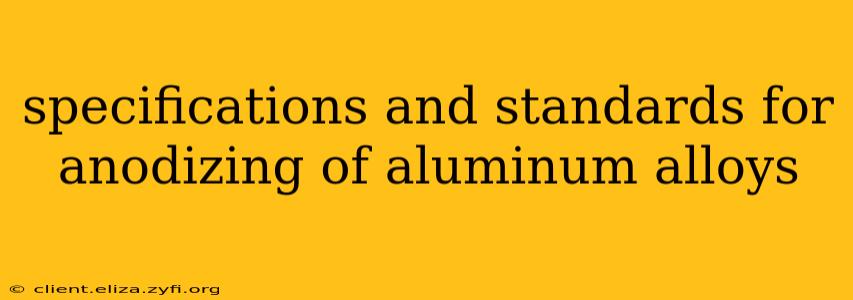Anodizing aluminum alloys is a crucial process for enhancing their durability, corrosion resistance, and aesthetic appeal. Understanding the specifications and standards governing this process is vital for ensuring consistent, high-quality results. This comprehensive guide delves into the key aspects, addressing common questions and providing detailed information to professionals and enthusiasts alike.
What are the different types of anodizing?
There are several types of anodizing processes, each catering to specific needs and offering varying properties. The most common are:
-
Chromic Acid Anodizing: This process produces a thin, relatively soft, and highly corrosion-resistant coating, often used for applications requiring good lubricity and dye receptivity.
-
Sulfuric Acid Anodizing: The most widely used type, sulfuric acid anodizing creates a thicker, harder, and more durable coating than chromic acid anodizing. It's highly versatile and suitable for a broad range of applications, including architectural components and transportation parts.
-
Hard Anodizing: This process utilizes higher voltages and colder temperatures than typical sulfuric acid anodizing, resulting in an exceptionally hard and wear-resistant coating. It's ideal for components subject to significant abrasion or friction.
What are the key standards and specifications for anodizing?
Several international and national standards govern the anodizing process, ensuring consistency and quality. These standards specify various aspects, including coating thickness, corrosion resistance, and colorfastness. Key standards include:
-
ASTM B580: This American standard covers the specifications for aluminum and aluminum-alloy coatings, including anodizing. It details various types of anodizing processes and provides requirements for coating thickness, corrosion resistance, and appearance.
-
MIL-A-8625F: While largely superseded, this military standard still holds relevance in certain sectors. It outlines specific requirements for anodizing aluminum components used in military applications.
-
ISO 10074: This international standard provides guidance on the anodizing of aluminum and aluminum alloys. It covers various aspects of the process, from pretreatment to post-treatment, helping to ensure consistency and quality.
What are the typical coating thicknesses for different anodizing processes?
Coating thickness is a crucial factor determining the performance and durability of anodized aluminum. Typical thicknesses vary depending on the anodizing type and intended application:
-
Chromic Acid Anodizing: Typically ranges from 0.5 to 2.0 μm.
-
Sulfuric Acid Anodizing: Typically ranges from 5 to 25 μm, with thicker coatings offering greater protection.
-
Hard Anodizing: Can reach thicknesses of 25 to 200 μm or even more, providing exceptional hardness and wear resistance.
How is the corrosion resistance of anodized aluminum measured?
Corrosion resistance is assessed through various methods, including:
-
Salt Spray Testing (ASTM B117): This widely used test exposes anodized aluminum to a salt spray environment to determine its resistance to corrosion. The results are typically reported as the number of hours the coating withstands the test without significant degradation.
-
CASS Test (Copper Accelerated Acetic Acid Salt Spray Test): This accelerated corrosion test is more aggressive than the standard salt spray test and is useful for evaluating the long-term corrosion resistance of anodized aluminum.
What are the common defects in anodizing and how are they prevented?
Several defects can occur during the anodizing process, including:
-
Pitting: Small holes or depressions in the coating. This can be caused by impurities in the aluminum surface or inconsistencies in the anodizing process.
-
Blistering: Formation of bubbles or blisters in the coating. This can be due to trapped gases or improper processing parameters.
-
Discoloration: Uneven or undesirable color in the coating. This could arise from issues with the dyeing process or exposure to contaminants.
Proper surface preparation, meticulous process control, and careful adherence to established standards are crucial in preventing these defects.
What are the environmental considerations of anodizing?
Environmental concerns are increasingly significant in the anodizing industry. Wastewater treatment is crucial to minimize the environmental impact. Sustainable practices, including reducing energy consumption and minimizing chemical usage, are gaining importance.
This overview offers a foundational understanding of the specifications and standards governing the anodizing of aluminum alloys. For specific applications and detailed requirements, always consult the relevant industry standards and seek advice from experienced anodizing professionals.
